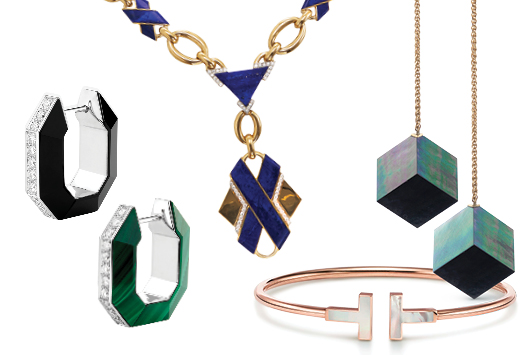 Lapis lazuli
Lapis lazuli
Scientifically categorized as a metamorphic rock, this stone is known for its deep-blue hues — a result of lazurite, a blue silicate mineral. The gold flecks that give it its “starry night” look are courtesy of pyrite.
While lapis lazuli is mined mainly in Russia, Afghanistan and Chile, people’s love for it spans countries and civilizations. Lapis lazuli has long been a prized possession among royal figures, whether in ancient Egypt, medieval Europe or Buddhist society. Symbolizing authority and honor, divinity and power, spirit and vision, it has appeared in jewelry, clothing and even burial ornaments.
Today, it is commonly cut into cabochons, carvings or beads. Having stayed off the radar for a few years, it’s back in jewelry, and designers are getting more creative with it than ever. For most gems, preferences lean toward “the clearer, the better,” but with lapis lazuli, the distribution of gold flecks can increase a stone’s beauty and value.
David Webb, one of the most colorful brands in the US, has often made creative use of the gem’s midnight-blue shade, taking advantage of how beautifully it pairs with white, yellow and even rose gold. The stone also works wonderfully with corals, emeralds, rubies and most other colored gemstones.
It’s made its way into high jewelry as well: Louis Vuitton’s recent Riders of the Knights collection pairs a lapis lazuli disk with diamonds and an emerald in one of its bracelets.
Mother-of-pearl
The shiny nacre that makes up the outer coating of pearls is the same rainbow-like, iridescent material that coats the inner layer of mollusk shells. This latter substance is known as mother-of-pearl and is highly prized. While good-quality pearls are rare and costly, the resilient and organic mother-of-pearl is much less expensive due to its abundance: Though not all mollusks will contain a pearl, they all come with mother-of-pearl coatings.
Easy to cut into shapes and available in a range of colors — from white, golden yellow and pink to green and black — mother-of-pearl has been used for centuries in architectural features like tiles, windows and inlay. It has also been popular for decorating items like buttons, watches, guns, cutlery, boxes and musical instruments.
Mother-of-pearl has appeared in jewelry for thousands of years, mainly as a way to add elegance and shimmer to a piece. Lately, the world of fine jewelry has started tapping into the full potential of this fantastic material. London-based designer Melanie Georgacopoulos, for instance, shapes it into discs, cubes, and an array of gemstone cuts that give it the appearance of faceted diamonds. Glistening like fish scales, these pieces are modern, bold and fun to wear.
Jewelry giant Tiffany & Co.’s fast-selling Tiffany-T collection also represents a mother-of-pearl revamp. Stylized forms of the letter “T” in rose, yellow and white gold are tiled with mother-of-pearl for bracelets, ear studs, pendant necklaces and rings that have been flying out of the display cases.
Malachite
This opaque, striped gemstone derives its vibrant green color from the presence of copper and was first mined in Britain as early as 3,800 years ago. For many, malachite echoes a connection with nature and represents the beginning of a new life. It was often used as a pigment in paintings and tombs. Once found in the Ural Mountains of Russia, the best samples are now being unearthed in Australia — specifically Queensland, New South Wales and South Australia.
Lapidaries most often cut malachite into cabochons, tablets and beads for jewelry use, planning the cut around the banding and the eye of the stone. Larger pieces may be carved into ornamental objects like boxes and vases. The rich bands of alternating dark and light green create mesmerizing patterns so that no two malachites are alike.
Van Cleef & Arpels’s everyday-wear collections are playful by design, and introducing malachite infuses them with even more fun. Striped malachite tablets make the clover leaves of the maison’s Alhambra line look almost real, and the pearl-shaped beads of its Perlee collection appear ready to bounce out of their casings. The deep green bands of malachite also aid in design, as they pair well with both yellow and white gold.
High jeweler Boucheron has used this stone in Art Deco inspirations, combining it with black onyx for a striking look. From edgy hoops to fringe and tassel necklaces, Boucheron’s design team is slowly bringing these older styles back into fashion.
Images: Boucheron, David Webb, Tiffany&Co., Melanie Georgacopoulos. Article from the Rapaport Magazine - June 2020. To subscribe click here.